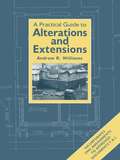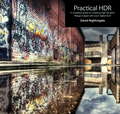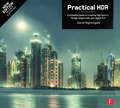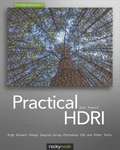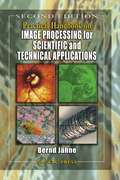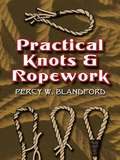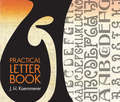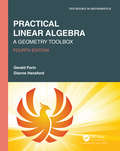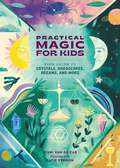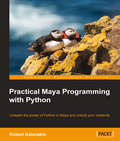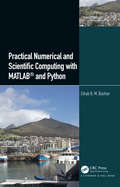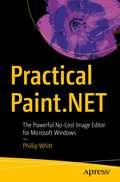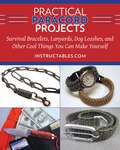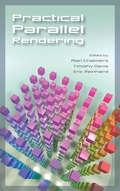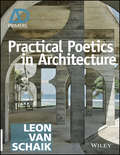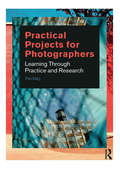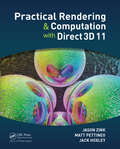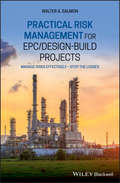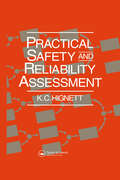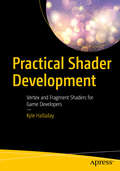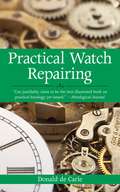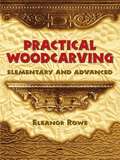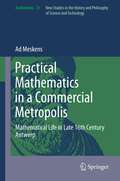- Table View
- List View
Practical Guide to Alterations and Extensions
by Andrew R. WilliamsThis simple-to-use, practical guide to altering or extending property is invaluable to all those who are trying to ensure that the processes involved are carried out efficiently and cost-effectively. For those working or planning to work in the construction industry, it will remind them of the pitfalls of local requirements, building control and planning.
Practical HDR (2nd Edition): The Complete Guide To Creating High Dynamic Range Images With Your Digital Slr
by David NightingaleThe first edition of David Nightingale's Practical HDR swiftly established itself as the standard work on this cutting-edge processing technique, garnering rave reviews and reprinting several times. Now, technical advances in the field have expanded HDR's possibilities still further, and this second, expanded edition, revised throughout, will cement David's reputation as the most respected writer in the field.Covering new programs, in particular Adobe CS5's HDR capabilities, and with more killer photos from the world's leading lights in HDR processing, Practical HDR will let the reader create jaw-dropping images that demand a second look.
Practical HDR: A complete guide to creating High Dynamic Range images with your Digital SLR
by David NightingaleHDR is both a technical solution to the limitations of digital camera sensors, and a creative tool that can give any image much more impact - but it is not without its pitfalls, and it's essential to understand these if you want to take full advantage of this innovative technique. The second edition of David Nightingale's successful Practical HDR is completely updated with the latest techniques and technologies in HDR. Practical HDR provides you with an abundance of step-by-step examples that will quickly make you an expert on the theory and practice of shooting and processing HDR images, allowing you to get the best possible results every time. As well as practical advice on shooting and processing, the book also contains a global showcase of inspirational HDR images - you will quickly find that HDR offers unparralleled opportunities for indulging your creative instincts, from photo-realistic to hyper-realism.
Practical HDR: The Complete Guide To Creating High Dynamic Range Images With Your Digital Slr
by David NightingaleHDR - High Dynamic Range - photography enables photographers to combine multiple exposures and to show scenes as we perceive them with our own eyes. 'Practical HDR' tells you everything you need to know about the topic, with an overview of the technicalities, step-by-step advice, and a global showcase of exceptional HDR images.
Practical HDRI
by Jack HowardPractical HDRI, 2nd Edition, by pro photographer Jack Howard, leads you into the the new frontier of High Dynamic Range Imaging, a multi-shot technique to digitally capture, store, and edit the full luminosity range of a scene in ways not possible in a single captured image. Fully updated for 2010, the 2nd Edition covers the HDR process from image capture through post-processing for web and print. Practical HDRI, 2nd Edition is richly illustrated with step-by-step tutorials for creating professional results using the leading HDR software titles, including the latest versions of Adobe Photoshop, Photomatix Pro, FDRTools, Dynamic Photo HDR, and HDR PhotoStudio. Howard instructs from experience as a photographer and a writer, with an emphasis on making the HDR process work for you. Topics include: Step-by-step tutorials Basic and advanced workflows and workarounds Web and print optimization File management, keywording Advice on cameras, gear and software HDR imaging can be challenging and frustrating for the uninitiated, as it involves both field and computer expertise. However, Jack Howard explains this complex subject matter in a practical way that will not intimidate the beginner, nor bore the experienced photographer. The emphasis is on the creative process and how to make it work for you-rather than the science behind it.
Practical Handbook on Image Processing for Scientific and Technical Applications
by Bernd JahneThe second edition of a bestseller, this book is a practical guide to image processing for the natural and technical sciences community. Students, practitioners, and researchers can gain immediate access to a sound basic knowledge of image processing by referencing general principles in the natural sciences. The book describes carefully selected algorithms in detail and demonstrates real-world applications that show the reader how to solve complex image processing problems. Hundreds of photos, figures, diagrams, and tables illustrate the text, and numerous well-organized tips save countless hours in the practical handling of image acquisition and processing.
Practical Knots and Ropework
by Percy W. BlandfordIn this thoroughly modern guide, author Percy W. Blandford focuses on styles in use today, many tailored to new synthetic ropemaking materials. He untangles the secrets behind a fascinating array of knots, including:Basic knots, from common bends to bowlinesJoining knots, including the "weaver's," "surgeon's," and "thief" knotsRunning and multiple loopsFisherman's and climber's knots... plus many other varieties, as well as the best way to secure loops, rings, and hitches. A detailed look at splicing ranges from fundamentals to methods for use with braided rope and wire. More than 290 diagrams appear throughout the text, illustrating the step-by-step formation of every knot.
Practical Letter Book
by J. H. KaemmererCreated during an exciting period in the evolution of graphic design, this volume was initially published in 1911 as Kaemmerer's Practical Letter Book: Containing Several Hundred Alphabets in 140 Plates; Together with Descriptive Text, For the Use of Sign Painters, Show Card Writers, Decorators, Artists and Craftsmen. A century later, this magnificent compendium offers a useful reference for graphic artists and designers in many fields. The 140 plates feature numerous historic and modern styles from throughout Europe, including examples based on Latin, Greek, Hebrew, and Gothic originals. Selections include English and Dutch block letters; Roman, German, and French letters; script and Gothic letters; a variety of contemporary letters; foreign alphabets; numerals; and a sampling of monograms and vignettes. The compilation's original intent as a resource for sign painters ensures the eye-catching quality of its contents, making this volume an enduring source of possibilities and inspiration.
Practical Linear Algebra: A Geometry Toolbox (Textbooks in Mathematics)
by Gerald Farin Dianne HansfordLinear algebra is growing in importance. 3D entertainment, animations in movies and video games are developed using linear algebra. Animated characters are generated using equations straight out of this book. Linear algebra is used to extract knowledge from the massive amounts of data generated from modern technology. The Fourth Edition of this popular text introduces linear algebra in a comprehensive, geometric, and algorithmic way. The authors start with the fundamentals in 2D and 3D, then move on to higher dimensions, expanding on the fundamentals and introducing new topics, which are necessary for many real-life applications and the development of abstract thought. Applications are introduced to motivate topics. The subtitle, A Geometry Toolbox, hints at the book’s geometric approach, which is supported by many sketches and figures. Furthermore, the book covers applications of triangles, polygons, conics, and curves. Examples demonstrate each topic in action. This practical approach to a linear algebra course, whether through classroom instruction or self-study, is unique to this book. New to the Fourth Edition: Ten new application sections. A new section on change of basis. This concept now appears in several places. Chapters 14-16 on higher dimensions are notably revised. A deeper look at polynomials in the gallery of spaces. Introduces the QR decomposition and its relevance to least squares. Similarity and diagonalization are given more attention, as are eigenfunctions. A longer thread on least squares, running from orthogonal projections to a solution via SVD and the pseudoinverse. More applications for PCA have been added. More examples, exercises, and more on the kernel and general linear spaces. A list of applications has been added in Appendix A. The book gives instructors the option of tailoring the course for the primary interests of their students: mathematics, engineering, science, computer graphics, and geometric modeling.
Practical Magic for Kids: Your Guide to Crystals, Horoscopes, Dreams, and More
by Nikki Van De CarFrom the bestselling author of The Junior Witch's Handbook comes an introduction to the charmed world of magic—featuring enchanted information on crystals, horoscopes, dreams, and more! From sparkly crystals and healing plants to the constellations that move across the night sky, the world is full of magic! In Practical Magic for Kids, author Nikki Van De Car teaches readers ages eight to twelve about the magic all around them. Kids will learn how to interpret their horoscopes, read their friends' palms, decode their dreams, and so much more in this approachable, age-appropriate guide. Full-color illustrations throughout will help young mystics explore the magic in plants, tarot cards, and even themselves, in chapters on: Chakras Auras Crystals Plant-based Magic Magical Holidays Magic Spells Tarot Astrology Palmistry Dream Interpretation An enchanted glossary and resources for further reading will help build upon the spark of magic.
Practical Maya Programming with Python
by Robert Galanakis"Practical Maya Programming with Python" is a practical tutorial packed with plenty of examples and sample projects which guides you through building reusable, independent modules and handling unexpected errors. If you are a developer looking to build a powerful system using Python and Maya's capabilities, then this book is for you. Practical Maya Programming with Python is perfect for intermediate users with basic experience in Python and Maya who want to better their knowledge and skills.
Practical Numerical and Scientific Computing with MATLAB® and Python
by Eihab B. BashierPractical Numerical and Scientific Computing with MATLAB® and Python concentrates on the practical aspects of numerical analysis and linear and non-linear programming. It discusses the methods for solving different types of mathematical problems using MATLAB and Python. Although the book focuses on the approximation problem rather than on error analysis of mathematical problems, it provides practical ways to calculate errors. The book is divided into three parts, covering topics in numerical linear algebra, methods of interpolation, numerical differentiation and integration, solutions of differential equations, linear and non-linear programming problems, and optimal control problems. This book has the following advantages: It adopts the programming languages, MATLAB and Python, which are widely used among academics, scientists, and engineers, for ease of use and contain many libraries covering many scientific and engineering fields. It contains topics that are rarely found in other numerical analysis books, such as ill-conditioned linear systems and methods of regularization to stabilize their solutions, nonstandard finite differences methods for solutions of ordinary differential equations, and the computations of the optimal controls. It provides a practical explanation of how to apply these topics using MATLAB and Python. It discusses software libraries to solve mathematical problems, such as software Gekko, pulp, and pyomo. These libraries use Python for solutions to differential equations and static and dynamic optimization problems. Most programs in the book can be applied in versions prior to MATLAB 2017b and Python 3.7.4 without the need to modify these programs. This book is aimed at newcomers and middle-level students, as well as members of the scientific community who are interested in solving math problems using MATLAB or Python.
Practical Paint.NET: The Powerful No-Cost Image Editor for Microsoft Windows
by Phillip WhittLearn to use the most up-to-date version of Paint.NET, the free, Windows-based program for image editing. This book is ideal for PC users who find Microsoft Paint too lacking, and Photoshop or GIMP too overwhelming. Paint.NET is a lightweight yet capable program that’s easy to navigate and is regularly updated. You’ll quickly become acquainted with this powerful, yet easy-to-learn program’s features; tools, layers, adjustments, and effects. See how to correct exposure, digitally retouch and repair damaged photos, and handle a broad spectrum of photo editing tasks—even how to colorize a black-and-white image. You’ll also learn how to create digital art using the Paint.NET drawing tools and effects. Practice files are provided with step-by-step instructions to jump into photo editing and art creation.Practical Paint.NET highlights this powerful program's rich set of features and capabilities providing you the pathway for just about any kind of image editing. Join the large community behind it today!What You'll LearnUse layers, which are essential in any professional quality image editing programAcquire and install plugins to maximize Paint.NET’s capabilitiesEnhance, retouch, and modify digital imagesCreate compelling digital artwork using the drawing tools and applying artistic filtersWho This Book Is ForWindows-based PC users who require the ability to edit digital images without the ongoing cost of subscription-based software, or complex open-source software. This group includes art or photography instructors (especially those in schools systems with limited budgets), small business owners, casual photographers, aspiring graphic designers, or anyone requiring a solid, basic editing program.
Practical Paracord Projects: Survival Bracelets, Lanyards, Dog Leashes, and Other Cool Things You Can Make Yourself
by Instructables. ComParachute cord, which is now universally known as paracord, is a lightweight nylon rope originally used by paratroopers during World War II. It is now employed as a general purpose utility cord by military personnel and civilians alike. <P><P>Paracord is an ideal material for making whips, for example, due to its durability and flexibility. Hikers and other outdoor enthusiasts have made "survival bracelets" from paracord, which are meant to be unraveled when needed to secure cargo, lash together poles, and fix broken straps and laces. As more colors become available, crafters are discovering that paracord makes an excellent material for fun and stylish friendship bracelets, lanyards, belts, dog leases, key chains, and more.Originating from Instructables, a popular project-based community made up of all sorts of people with a desire to pass on their wisdom to others, Practical Paracord Projects contains ideas from a number of authors who show just how easy it is to make virtually anything from paracord.Practical Paracord Projects provides step-by-step instructions on a variety of useful and fun objects involving paracord. Guided by detailed photographs, the reader will create such practical and unusual projects as:A laptop harnessA can koozieAn eyeglass lanyardA hanging chairSandalsA leatherman pouchAnd much more!
Practical Parallel Rendering
by Jessica KeyesMeeting the growing demands for speed and quality in rendering computer graphics images requires new techniques. Practical parallel rendering provides one of the most practical solutions. This book addresses the basic issues of rendering within a parallel or distributed computing environment, and considers the strengths and weaknesses of multiprocessor machines and networked render farms for graphics rendering. Case studies of working applications demonstrate, in detail, practical ways of dealing with complex issues involved in parallel processing.
Practical Poetics in Architecture (Architectural Design Primer)
by Leon van SchaikIntegrate poetics into real-world spaces by bringing theory down to earth Practical Poetics in Architecture takes poetics out of the theory class and into the design studio, showing architects how the atmospheric and experiential qualities of built structures can be intentionally considered and planned. With an emphasis on analysing and explaining the sensibility of poetics at work in designing and constructing architecture, this book features projects from architects around the world that demonstrate the principles of poetics come to life. The rich illustration of two hundred colour images, including analytical diagrams, plans, sections, and photos, make this insightful guide a highly visual foray into a topic that has thus far remained more theoretical than practical. The text is matter-of-fact and concrete, yet remains richly connected to its forbears and the writings of William Lethaby, Gaston Bachelard, and Steen Eiler Rasmussen. The perspective is contemporary in its examples and its connections to the evolving science of perception. An established seminar topic in theory classes around the world, poetics tends to rely heavily on classic philosophic texts — until now. Practical Poetics in Architecture brings theory down to earth to show architects how to invoke poetics when designing real projects. Integrate poetics principles into real-world designs Consider atmosphere in terms of form, space, and acoustics Study actual projects that bring poetics into real spaces Take cues from analytical diagrams of projects accounting for context Poetics — the accumulated experience of place, space, and culture — has become more critical in recent years as the atmospheric and experiential qualities of built spaces have become more elusive in the virtual age. Practical Poetics in Architecture provides real guidance for real projects, and brings poetics out of the mind and onto the plans.
Practical Projects for Photographers: Learning Through Practice and Research
by Tim DalyExpert photographer and instructor Tim Daly presents over 20 practical projects for the budding photographer to develop their technical and research skills.Each project is a ready-made resource - the assignments vary in size and complexity, exploring a wide range of outputs (print, photobook, blog) and are mindful of limited resources, travelling distances and access to expensive equipment. Within each section are examples of notable photographers from around the world, suggested responses, practice tips, readings from key thinkers and further resources. This book blends understanding of context and technique to help photographers find new ways to work through the creative process.
Practical Rendering and Computation with Direct3D 11
by Jason Zink Matt Pettineo Jack HoxleyDirect3D 11 offers such a wealth of capabilities that users can sometimes get lost in the details of specific APIs and their implementation. While there is a great deal of low-level information available about how each API function should be used, there is little documentation that shows how best to leverage these capabilities. Written by active me
Practical Risk Management for EPC / Design-Build Projects: Manage Risks Effectively - Stop the Losses
by Walter A. SalmonMany of the books on construction risk management concentrate on theoretical approaches to the accurate assessment of the overall risks of taking on a new project. Less attention is paid to the typical risks to which the operational level of a project is exposed and how operational managers should approach those risks during project implementation. This book identifies precisely where the major EPC/Design-Build risks occur within an operational framework and shows how best to deal with those risks. The book attempts to offer practical advice, approaches and tools for dealing with risks to which the various operational departments are exposed.
Practical Safety and Reliability Assessment
by K.C. HignettAn integral part of any engineering or manufacturing process is a continuous process of assessing its safety and reliability. This work provides a guide to the practical application of safety and reliability principles wherever risk is a consideration. The theory and mathematics are kept to a minimum, whilst a practical working model of the technology is presented for everyone involved in general engineering disciplines. It reduces the high cost of using professional consultant practitioners, introduces an advanced methodology of common mode failure analysis and modelling, with potential savings on system capital costs, and provides an illustration of working principles by graded tutorial projects.
Practical Shader Development: Vertex and Fragment Shaders for Game Developers
by Kyle HalladayIt’s time to stop thinking that shaders are magical. You can use shaders to turn data into stunning visual effects, and get your hands dirty by building your own shader with this step-by-step introduction to shader development for game and graphics developers. Learn how to make shaders that move, tint, light up, and look awesome, all without cracking open a math textbook.Practical Shader Development teaches the theory behind how shaders work. The book also shows you how to apply that theory to create eye-popping visual effects. You’ll learn to profile and optimize those effects to make sure your projects keep running quickly with all their new visuals. You’ll learn good theory, good practices, and without getting bogged down in the math. Author Kyle Halladay explains the fundamentals of shader development through simple examples and hands-on experiments. He teaches you how to find performance issues in shaders you are using and then how to fix them. Kyle explains (and contrasts) how to use the knowledge learned from this book in three of the most popular game engines today. What You'll LearnUnderstand what shaders are and how they workGet up to speed on the nuts and bolts of writing vertex and fragment shadersUtilize color blending and know how blend equations workKnow the coordinate spaces used when rendering real-time computer graphicsUse simple math to animate characters, simulate lights, and create a wide variety of visual effectsFind and fix performance problems in shadersSee how three popular game engines (Unity, UE4, Godot) handle shadersWho This Book Is ForProgrammers who are interested in writing their own shaders but do not know where to start, anyone who has ever seen shader code on a forum and wished they knew how to modify it just a little bit to fit into their own projects, and game developers who are tired of using the default shaders found in the game engines they are using. The book is especially useful for those who have been put off by existing shader tutorials which introduce complex math and graphics theory before ever getting something on the screen.
Practical Watch Repairing
by Donald De CarleThe absorbing and everlasting subject of watch repairing has been dealt with in books in many languages throughout the years. But when de Carle first set out to write Practical Watch Repairing in 1946, it was with the intention of creating a textbook "that a watchmaker can understand, even if he can't read." With over 550 instructional black-and-white illustrations and an approach that assumes no prior watch-repairing experience, this book achieves and surpasses that lofty mission, and has been touted as "the best illustrated book on practical horology" (Horological Journal) ever written. For the readers in his audience, de Carle has provided well-informed discourse on every topic a watchmaker, or aspiring watchmaker, needs to know. With Practical Watch Repairing, even a layman can become a watch-repair specialist.
Practical Woodcarving: Elementary and Advanced
by Eleanor RoweThis practical guide to woodcarving by an accomplished designer and carver not only provides expert tips on such basics as woods and tools, but also explains how to succeed in completing projects in low and high relief.More than 200 diagrams and photographs accompany clear, concise instructions, enabling novices and veteran woodworkers alike to recreate everything from Gothic tracery to sixteenth-century moldings and lettering. Part One deals with simple carving, gradually advances to slightly modelled detail, and offers expert advice on how to construct rails, chests, a stool, and cradle. Part Two provides examples of more advanced work, with descriptions of Renaissance designs and pierced carvings.Profusely illustrated with photographs and drawings, this volume will serve as a valuable resource for artists and craftspeople, inspiring creative efforts while offering a wealth of helpful hints and practical information.
Practical mathematics in a commercial metropolis
by Ad MeskensDescribes the development and the ultimate demise of the practice of mathematics in sixteenth century Antwerp. Against the background of the violent history of the Religious Wars the story of the practice of mathematics in Antwerp is told through the lives of two protagonists Michiel Coignet and Peeter Heyns. The book touches on all aspects of practical mathematics from teaching and instrument making to the practice of building fortifications of the practice of navigation.
Practice Management for Land, Construction and Property Professionals
by Brian GreenhalghPractice management for Land, Construction and Property Professionals presents the expert views and practical experience of researchers and practitioners concerned with the particular challenges and skills required to manage professional service organizations in the constuction and property industries. The book provides extensive coverage of the following key issues: management of creativity marketing of professional services professional ethics quality management business planning and strategic management Practice management for land, Construction and Property Professionals will be an important guide for those with management responsibiliie in the property and construction industries. Students working towards qualifications in the properrty and construction professions will also find the book a valuable reference and source of advice.
